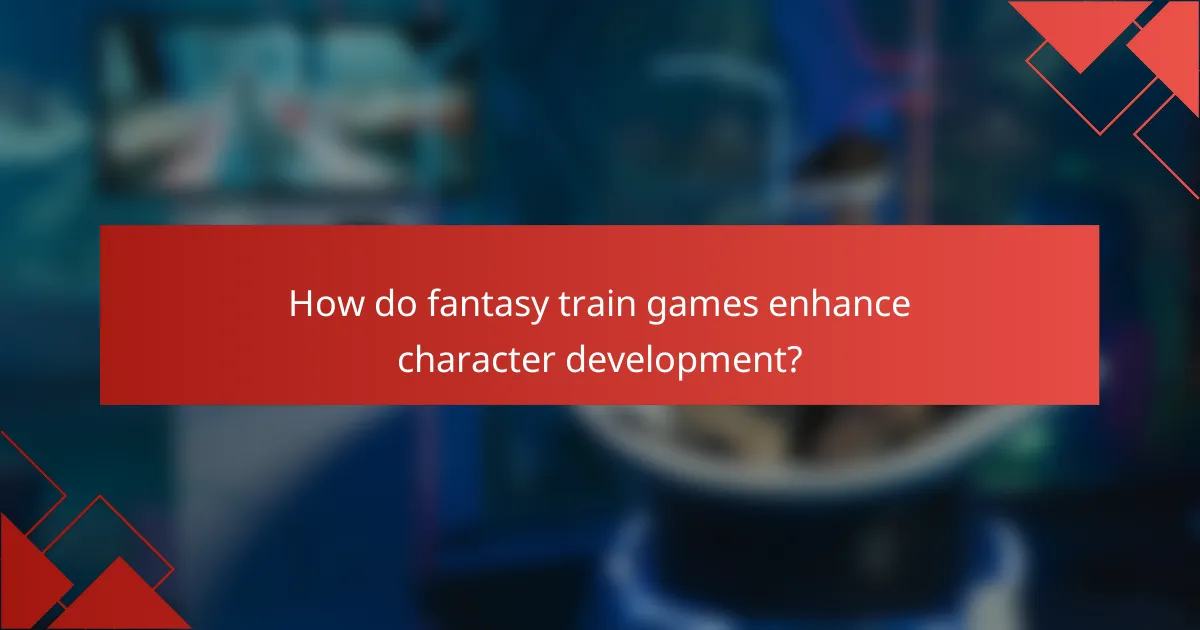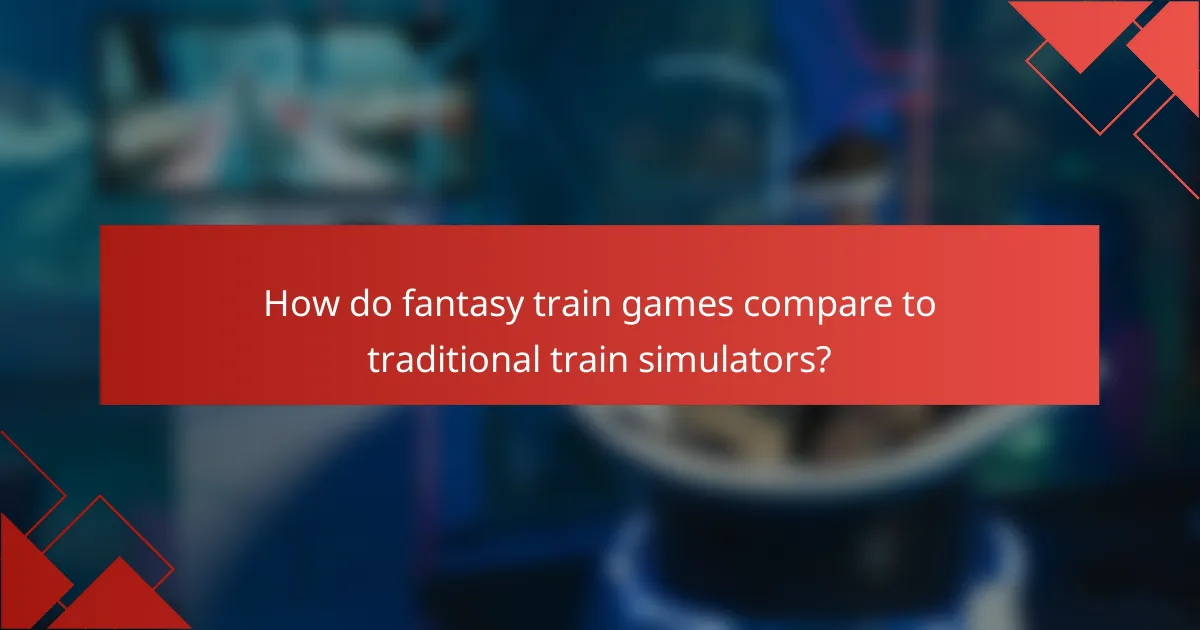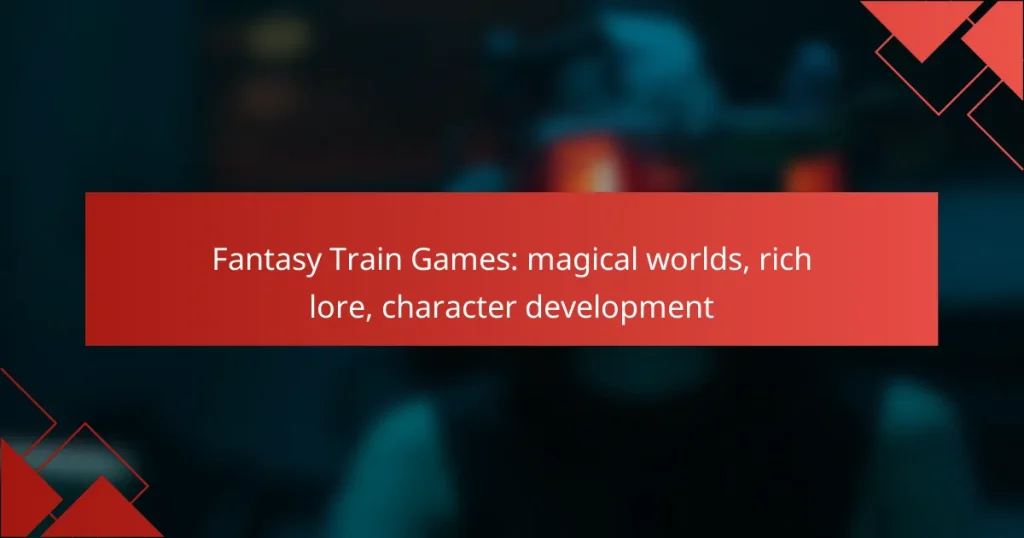Fantasy train games transport players to enchanting realms filled with rich lore and captivating narratives. These immersive experiences not only allow for exploration of magical worlds but also emphasize character development through engaging storytelling and customization. Titles like Train Valley 2 and Railway Empire exemplify how these elements come together to create unforgettable adventures.

What are the best fantasy train games available?
The best fantasy train games blend imaginative worlds with engaging gameplay, offering players unique experiences. Titles like Train Valley 2 and Railway Empire stand out for their rich lore and character development, making them favorites among fans of the genre.
Train Valley 2
Train Valley 2 is a puzzle and tycoon game where players build and manage a railway empire in a charming, cartoonish world. The game features a campaign mode with various scenarios that challenge players to optimize their train routes and resources.
Players can unlock new trains and technologies while expanding their networks, which adds depth to the gameplay. The combination of strategic planning and whimsical graphics makes it appealing to both casual and hardcore gamers.
Railway Empire
Railway Empire offers a more historical approach, allowing players to build a railway company in 19th century America. The game emphasizes economic management and competition, where players must outsmart rivals while developing their railroads.
With a focus on character development, players can hire and manage a diverse cast of characters, each with unique skills that can enhance operations. The rich lore and detailed environments create an immersive experience for fans of train simulations.
Unrailed!
Unrailed! is a cooperative multiplayer game that combines train building with survival elements. Players work together to gather resources and lay tracks to keep their train moving across procedurally generated landscapes.
The frantic pace and need for teamwork create a dynamic gaming experience. Players must strategize on resource allocation and track placement, making it a fun challenge for groups looking to test their coordination.
Fantasy Train Simulator
Fantasy Train Simulator immerses players in a magical realm where they can operate fantastical trains. The game features various environments, from enchanted forests to mystical mountains, each filled with unique challenges and quests.
Players can customize their trains and explore the lore of the world, engaging in missions that often involve solving puzzles or interacting with magical creatures. This blend of simulation and fantasy elements appeals to those seeking a more whimsical experience.
Little Big Train
Little Big Train is a charming game that focuses on building and managing a small railway system in a vibrant, cartoon-like world. Players can design their tracks and manage train schedules while interacting with quirky characters.
The game emphasizes creativity and exploration, allowing players to create their own routes and discover hidden treasures. Its lighthearted approach makes it suitable for younger audiences and casual gamers looking for a delightful experience.

How do fantasy train games enhance character development?
Fantasy train games enhance character development by integrating immersive storytelling, customization, and interactions that shape player experiences. These elements create a rich environment where players can explore their characters’ growth and relationships within magical worlds.
Character customization options
Character customization in fantasy train games allows players to tailor their avatars with unique traits, appearances, and abilities. Options may include selecting different races, classes, and skills that influence gameplay and narrative outcomes. This personalization fosters a deeper connection between players and their characters.
For example, a player might choose a mystical elf engineer with special crafting skills, impacting how they interact with the game world and other characters. This customization can significantly affect gameplay strategies and story arcs, enhancing the overall experience.
Story-driven gameplay
Story-driven gameplay in fantasy train games provides a narrative backbone that guides character development. Players often embark on quests that reveal their characters’ backgrounds, motivations, and relationships with others. Engaging plots encourage players to invest emotionally in their characters’ journeys.
As players progress through the game, they may face choices that affect their character’s development, such as moral dilemmas or alliances. These decisions can lead to multiple endings or character arcs, making each playthrough unique and personal.
Interaction with NPCs
Interactions with non-playable characters (NPCs) are crucial for character development in fantasy train games. NPCs often serve as mentors, rivals, or allies, providing quests and dialogue that enrich the player’s understanding of the game world. These relationships can evolve based on player choices, impacting character growth.
For instance, forming a bond with a wise old wizard might unlock new abilities or quests, while antagonizing a rival could lead to conflict and challenges. This dynamic interaction encourages players to think critically about their choices and how they shape their characters’ paths.

What magical worlds can be explored in fantasy train games?
Fantasy train games transport players to imaginative realms filled with enchanting landscapes, rich lore, and captivating narratives. Players can explore various magical worlds, each offering unique experiences and adventures that enhance gameplay and character development.
Enchanted forests
Enchanted forests in fantasy train games are often lush, vibrant environments filled with mystical creatures and hidden secrets. Players can navigate through winding tracks that lead to magical glades, where they may encounter fairies, talking animals, or ancient spirits.
These forests typically feature dynamic weather systems and day-night cycles, enhancing immersion. Players should pay attention to environmental cues, as certain paths may only be accessible during specific times or conditions.
Mythical cities
Mythical cities serve as bustling hubs of activity in fantasy train games, showcasing intricate architecture and diverse cultures. Players can explore marketplaces filled with unique items, interact with various characters, and uncover quests that deepen the lore of the game world.
These cities often have distinct factions or guilds, each offering different storylines and rewards. Engaging with these groups can lead to valuable alliances or rivalries, impacting the player’s journey and character development.
Ancient ruins
Ancient ruins provide a sense of history and mystery in fantasy train games, often containing remnants of lost civilizations. Players can uncover artifacts, solve puzzles, and piece together the lore of these forgotten places, which can significantly enhance their understanding of the game world.
Exploring ruins may require specific skills or tools, such as treasure maps or magical abilities, to access hidden chambers or decipher ancient texts. Players should be prepared for challenges, including traps or guardians that protect these sacred sites.

What are the key features of fantasy train games?
Fantasy train games combine imaginative worlds with unique gameplay mechanics, creating immersive experiences for players. Key features include rich lore, innovative train mechanics, and multiplayer options that enhance engagement and replayability.
Rich lore and storytelling
Rich lore is a cornerstone of fantasy train games, often featuring intricate backstories and mythologies that enrich the gameplay. Players may explore vast narratives that unfold as they progress, revealing secrets about the world and its inhabitants.
Storytelling can be enhanced through quests, character interactions, and environmental storytelling, where the setting itself conveys history and culture. Engaging narratives often encourage players to invest emotionally in their characters and the world around them.
Unique train mechanics
Unique train mechanics set fantasy train games apart from traditional train simulators. Players might manage resources, upgrade trains, or navigate magical obstacles, creating a dynamic gameplay experience that requires strategic thinking.
For example, some games allow players to customize trains with special abilities or magical enhancements, impacting how they traverse the game world. Understanding these mechanics is crucial for optimizing performance and achieving game objectives.
Multiplayer options
Multiplayer options in fantasy train games can significantly enhance the experience by allowing players to collaborate or compete with others. This can include cooperative missions, competitive races, or trading resources, fostering a sense of community among players.
When engaging in multiplayer modes, players should consider communication strategies and teamwork to maximize their effectiveness. Additionally, some games may offer seasonal events or challenges that encourage ongoing participation and interaction within the player community.

How do fantasy train games compare to traditional train simulators?
Fantasy train games differ from traditional train simulators by incorporating magical elements, rich storytelling, and character development, rather than focusing solely on realistic train operations. While traditional simulators emphasize accuracy and real-world physics, fantasy train games allow for creative exploration of imaginative worlds and narratives.
Magical Worlds in Fantasy Train Games
Fantasy train games often feature vibrant, imaginative environments that transport players to magical realms. These worlds can include enchanted forests, mystical cities, and surreal landscapes that enhance the gaming experience. Players can explore these settings while navigating their trains, encountering various fantastical elements along the way.
Rich Lore and Storytelling
Many fantasy train games are built around intricate lore and narratives that engage players on a deeper level. These stories often involve quests, character arcs, and conflicts that players can influence through their choices. The integration of lore adds layers to gameplay, making each journey feel significant and immersive.
Character Development in Fantasy Train Games
Character development is a key feature in fantasy train games, allowing players to build and evolve their characters throughout the game. Players can often customize their characters’ abilities, skills, and appearances, which can impact gameplay and interactions with the game world. This focus on character growth adds a personal touch to the gaming experience.


